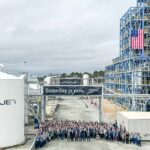The International Air Transport Association (IATA) has urged South Africa’s new government to prioritise the development of sustainable aviation fuel to help meet surging global demand from airlines, while also creating a significant new economic driver for the nation. Speaking at IATA’s ‘Wings of Change Focus Africa’ conference in Johannesburg, Marie Owens Thomsen, the organisation’s SVP for Sustainability and Chief Economist, referenced a new study by the World Wildlife Fund, that concluded South Africa had plentiful feedstocks from which to produce SAF and estimated the nation could produce up to 4.5 billion litres annually. “South Africa has vast potential to become a leading SAF producer in the region,” she said. “More than a strategy in support of aviation’s decarbonisation, it is a strategy for economic development and should be a top priority for the new government.”
The Wings of Change conference coincided with the release of IATA data which showed that in May, Africa’s airlines collectively achieved a 14.4% year-on-year increase in demand, an 8.2% increase in capacity and a rise of 3.7 percentage points in average passenger load factor. Although Africa’s overall load factor is the lowest of any region, the percentage increase in May was the highest, reflecting IATA projections of strong long-term growth by South Africa’s aviation sector.
“South Africa’s aviation industry is poised for significant growth over the next 20 years, adding 345 million additional passenger journeys by 2043,” said Kamil Alawadhi, IATA’s Regional VP for Africa and the Middle East. “With aviation generating $6 in economic activity for every $1 spent, this expansion will inject billions into South Africa’s GDP and create thousands of new jobs.”
Thomsen reiterated global SAF production was a fraction of what the aviation industry needs to help meet its net zero emissions targets.
“That’s why it’s essential for governments of countries with production potential, such as South Africa, to embrace what is a unique win-win opportunity for economic development, energy transition and decarbonised air transportation,” she said. “Across agriculture, energy and transportation, new jobs and industries are waiting to be created that would not only help fight poverty but also contribute to greater energy independence.”
The study by World Wildlife Fund (WWF) concluded South Africa had abundant feedstocks to help produce SAF, including low carbon by-products of sugarcane and biomass waste from cleared invasive alien plants, harvesting of which would also improve biodiversity and water security without competing with food production for land or water use.
“The WWF estimates that South Africa has the potential to produce between 3.2 and 4.5 billion litres of SAF annually,” said IATA.
“This will more than meet domestic fuel demand (1.8 billion litres) and present an export opportunity where policies will be essential for realisation. Achieving production at the higher range of potential would require the co-development of a green hydrogen capability.”
South Africa also had extensive experience in producing synthetic fuels, particularly via the Fischer-Tropsch conversion method, a multi-step chemical process through which biomass is converted to syngas, then transformed into jet or diesel fuel, said IATA.
As well, South Africa’s “robust” academic and research institutions had historically supported innovation and technology for production of fuels, while the country’s airports, including Johannesburg’s O.R. Tambo International Airport and Cape Town International Airport, were key hubs connecting the country internally, within Africa and beyond.
IATA reiterated that South Africa had chaired the 2022 ICAO Assembly, during which governments agreed to a long-term goal aligned with the air transport sector’s commitment to pursue net zero carbon emissions by 2050, and said the role of SAF was emphasised by the ICAO CAAF/3 objective of achieving by 2030 a 5% average global reduction in aviation’s carbon emissions.
To progress SAF production in South Africa, IATA called upon the government to develop a four-point strategic plan.
It should expedite the development of production facilities by using existing refinery infrastructure for ‘brownfield’ investments such as conversions of existing plants or co-processing and encourage collaboration with the private sector and international partners to share resources and expertise.
Incentives should also be provided for research and development to inspire innovation that could drive down costs and lift SAF production volumes, added IATA, as well as to support the development of greenfield infrastructure such as biorefineries and green hydrogen production, and diversification of fuel source crops and production methodologies.
“It is important for the new government to keep this as a strategic focus,” said Alawadhi. “The economic and social benefits of aviation will be maximised with a sharp policy focus on keeping costs low, providing sufficient capacity to grow, monitoring the cost-effectiveness of regulations, and achieving net zero carbon emissions by 2050.”
Photo (Wikipedia): South African Airways Airbus A319















More News & Features
Swiss advanced SAF technology startups Metafuels and Synhelion reach project milestones
PtX fuels have significant Asia-Pacific potential but face many barriers, finds report
Airfreight giants DHL Express and FedEx announce big US SAF deals
Asia-Pacific study reveals pessimistic outlook for SAF uptake by 2030 as Singapore details levy
Supply shortage means airlines have no chance of meeting a 10% SAF by 2030 target, says IATA chief
EU states to mobilise 500 million euro support for early-mover eSAF production startups